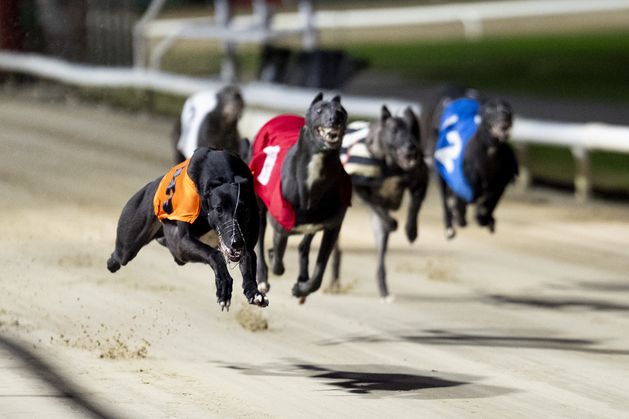A total of 389 greyhounds suffered injuries at races around Ireland in 2024 and more than half of them were killed, according to newly-released statistics.
The 202 deaths made 2024 the worst year for deaths at greyhound races since records began in 2014. The 389 injuries are the highest since 2016.
Last year’s figures brings to 3,696 the number of greyhounds injured and 1,396 the number killed in racing at Irish tracks since 2014.
The figures show that of the 389 greyhounds injured at race meetings between January and December, 194 of them were “euthanised” by track vets.
The deaths of eight other injured greyhounds are listed as racing fatalities – where it is noted they “died on the track or shortly after a race”.
The injury and death data – obtained by Paul Murphy TD following a Dáil question to the Minister for Agriculture – shows that the 194 greyhounds who were euthanised by vets had suffered injuries including: spinal injuries, spinal paralysis, broken necks/elbows/legs/hocks/wrists/radii and ulna/metatarsals.
It was also revealed that some suffered complete fractures of hind legs, suspected neck fractures, suspected nerve paralysis in shoulders, dislocated hocks, hip injuries, torn ligaments in wrists, ruptured tendons and shattered hocks, among others.
The 187 injured greyhounds that were not euthanised were treated for injuries including: bleeding feet, burst blood vessels in shoulders, flesh wounds, lacerations on the shoulder, broken leg/hock/toes, bruised flanks, a gashed flank and pelvic injuries, among others.
Post-mortems carried out on the bodies of the eight ‘racing fatality’ greyhounds showed that at Limerick stadium in February, one greyhound who “collapsed and died” had suffered abdominal haemorrhage.
A greyhound who “collapsed and died” at Mullingar stadium in April, had suffered acute heart failure, while one greyhound who died after a race at Youghal track in May suffered “haemothorax following multiple rib fractures”.
At Tralee track in May, a greyhound died with a “suspected broken neck and internal haemorrhaging”.
The worst days of the year for greyhound deaths at races were on May 4, where five injured greyhounds were euthanised by track vets at Youghal (2), Shelbourne Park (1), Thurles (1) and Galway (1).
On September 6, five injured greyhounds were euthanised by track vets at Clonmel (2), Kilkenny (1), Curraheen Park (1) and Newbridge (1).
The Irish Council Against Blood Sports (ICABS) said Greyhound Racing Ireland (GRI) is “again attempting to downplay the high numbers of injuries and deaths.”
They stressed that Greyhound Racing Ireland told Paul Murphy TD that the 389 greyhounds injured “represents 0.40pc of the total number of greyhounds that raced on GRI-licensed tracks during that period (97,621 runners)”.
They also said Deputy Murphy was told the 202 deaths “represents 0.21pc of the total number of greyhounds that raced on GRI-licensed tracks during that period”.
“However, this is entirely misleading as the figure of 97,621 actually relates to race entries and is not a “total number” of individual greyhounds.
“According to previously published GRI data, the number of greyhounds in the ‘racing pool’ over a year is around 4,850. This means that the actual percentage of greyhounds injured and killed is substantially higher,” it said in a statement.
The organisation also criticised Government grants for the greyhound racing industry, of which €366,986,146 has been allocated between 2001 and 2025.
This year, €19,820,000 was allocated, last year €19,000,000 and in 2023, €18,200,000. Pre-Covid, in 2019, €16,800,000 was granted.
ICABS said: “How many more dogs have to suffer and die before the Irish Government stops the funding that is propping up greyhound racing?”
“Wales this week announced that greyhound racing will be phased out ‘as soon as practicably possible’. It’s time for the Irish Government to follow suit and bring to an end the suffering and deaths of dogs at tracks,” the council added.
In response, Greyhound Racing Ireland said: “Any increase in fatalities or injuries at tracks is regrettable and small fluctuations will occur from year to year as has been the case between 2024 and 2023 and with the decrease in overall track fatalities recorded between 2022 and 2023.
“Comprehensive track maintenance procedures are operated at GRI/RCÉ stadia to ensure that the best possible arrangements are provided for greyhound racing.
“Stadium management uphold a focused scrutiny on the seeding of greyhounds to alleviate the possibility of race crowding, while greyhounds that underperform or in general have run poorly in consecutive races must undertake a performance trial to prove their wellbeing.
“Furthermore, greyhound welfare standards have been further improved through the Code of Practice and reinforced through greyhound traceability in the form of RCÉTS.
“Veterinary practitioners attend all race meetings and sales trials at RCÉ licensed venues and are the appropriate competent person to make decisions regarding the welfare of a greyhound.
“Furthermore, RCÉ works closely with greyhound owners/trainers to ensure every effort is made to minimise injuries to racing greyhounds at all tracks,” they added.
